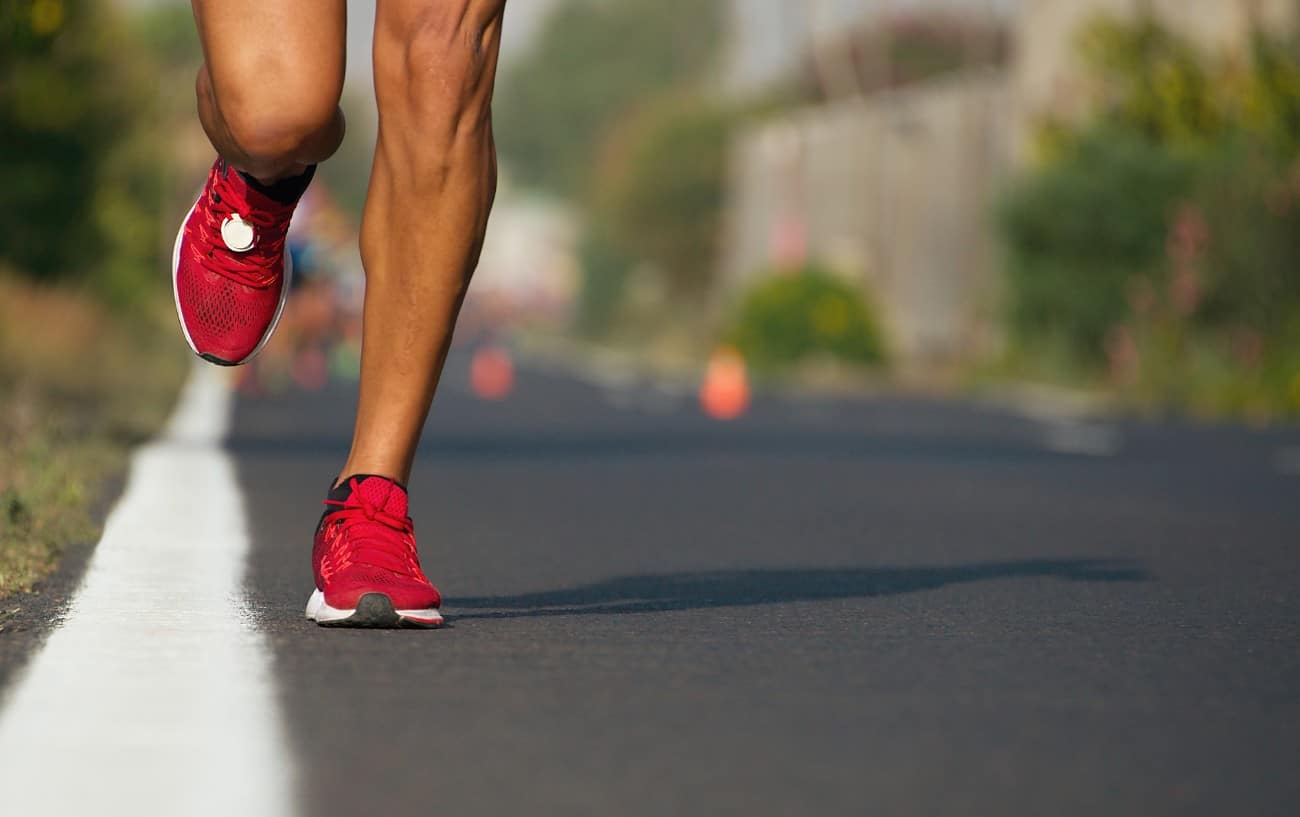How to Increase Running Cadence: 3 Fail-Proof Tips to Try
Reviewed by: Sergii Putsov (PhD in Sport Science)
Many runners, whether they are professionals or amateurs, strive to run faster and more efficiently. In search of helpful information, you can come across many unfamiliar words: heart rate zones, stride length, and running cadence. But what does cadence mean in running?
To achieve good results in running, it is essential to continuously improve the technique, particularly the running cadence, in other words, the frequency of steps. It can affect both the result and your health.
This article will discuss running cadence, its average value, and how a high cadence level will help you run faster and safer. Do you want to know what running cadence should be, how to train it, and what benefits it gives a runner? Then let’s dive in!
Running cadence is the frequency you touch the ground with your feet while running for 60 seconds. Its value is measured in the number of steps per minute – spm. This indicator affects the quality of running and the overall health of your body. You can learn how to improve your running cadence with specific exercises.

What Is Running Cadence?
Let’s start with the question, “What does cadence mean in running?” The word cadence means rhythm, pace, and the number of movements per minute. Cyclists are familiar with “revolutions per minute” (RPM), and they aim to cycle faster and more frequently. RPM is the cadence of cyclists. But what is cadence in running?
Cadence is the frequency with which the runner’s foot touches the ground during the run. The speed and quality of running depending on the length and frequency of steps. The longer your stride, the more area you cover, and the more steps you take per minute, the greater the distance you can cover. Now let’s discuss what is a good running cadence.
Average Value of Running Cadence
The vast majority of amateurs run at low cadence without even realizing it. The average cadence of amateurs ranges from 150 to 165 steps per minute. Tall people always have a lower cadence because their legs are longer, and it is more difficult for them to take frequent steps.
So what is a good cadence for running? The average running cadence varies from 175 to 185 steps per minute. If your cadence is lower, this indicates a generally inefficient use of muscles and your resources.
The human musculoskeletal system consists of three types of tissues:
- Hard – bones;
- Elastic contractile – muscles;
- Elastic non-contractile – tendons, ligaments, and cartilage.
People use all these tissues while running.
When people run at a low cadence of 150-160 strides per minute, they use too much muscle effort. This results in more energy expenditure and reduces the ability of elastic tissues to enhance natural forward movement. Now let’s discuss the benefits a higher cadence can give you.
Why Should I Increase My Running Cadence?
If you run with a cadence of 175-185 strides per minute, your steps become shorter at the same speed as 150 strides per minute. The 150-cadence runner puts in more muscle effort, has a longer stride, and lands in front of the body rather than under the center of gravity.
Muscles are attached to bones by tendons, and a large muscle effort causes them to stretch excessively. If this process is repeated daily, it can cause tendon inflammation.
A high-cadence runner lands close to the center of gravity; therefore, there is no slowing while moving. With increased speed, the frequency of steps should also increase, not just their length.
Increasing cadence improves endurance and reduces injuries during running. First of all, a high cadence is necessary for runners who choose to run long distances. While running regularly with a low cadence, there is a risk of developing the following issues:
- Inflammation of the tendons;
- Knee injury;
- Sprains.
If you have a cadence of 160, you are likely to put your foot far in front of you and most often step on the heel. Such a landing increases the likelihood of injury.
When you place your foot closer to your center of gravity, your foot acts as a physiological shock absorber. This reduces the risk of injury by reducing the impact on the feet. A higher cadence improves this component of running.
In addition to an increased risk of injury, low cadence causes slower movement when landing on foot, negatively affecting overall running speed and endurance.
Subscribe to Our Running Newsletter!
Get free running tips from renowned professional athletes and discounts from top-notch brands.
How to Measure Running Cadence?
Before you can develop a program to increase your running cadence, you need to measure this parameter correctly. The easiest way is to choose one foot, count the steps for a minute and then multiply by two. It is worth repeating the measurements several times and calculating the average value to make the result more accurate. For precise measurements, you should not increase the cadence during the measurements. Try to run at your natural pace.
Also, you can use various running devices. Sports watches or sensors placed in sports shoes also measure your cadence. You can choose from various smartphone apps that calculate your running rhythm.
If, according to the results of the measurements, you got a low cadence, you should consider increasing it. Studies show that even a minimal increase in the 4-5% cadence helps significantly reduce the load on the knee joints and improve running performance.
3 Tips for How to Increase Cadence While Running

1. Tune in to the Right Rhythm
The easiest way to increase running cadence is to match your running rhythm to the sound of a metronome. This device marks short periods with constant sounds, helping you improve your running rhythm. Attach an electronic metronome to your belt, or install one of the many apps on your phone. Try to cover a short distance so that the frequency of steps coincides with the frequency of the sound signal.
You can also run to the beat of the music you listen to during your workout. To begin with, get into a comfortable workout pace. Once you’ve reached a steady speed, turn on the metronome and increase or decrease it until it matches your current running pace.
Then, increase your pace by 5% and try to keep it as you run the next mile. After that, let the body work at any frequency that seems normal. Gradually increase your running time while maintaining your target cadence until your entire run matches your new, faster cadence.
You can use the metronome throughout your run to make sure you’re hitting your target cadence, or you can turn it on sometimes while you run to check your performance and get back on track.
2. Control your Stride Length
Do not try to drastically shorten your steps because it depends on your physical condition and the regularity of training. Moreover, a sharp reduction will cause the foot to lose its usual center of gravity and slow the movement. Try to place the foot under the knee when it touches the ground.
Pay attention to the straight position of the back, and try not to sway from side to side. One of the most popular mistakes among beginners is that they look down. In this case, they get tension in the cervical spine.
The frequency and length of steps should remain more or less constant at different distances and different paces. You should not worry if you still have a slight difference because even professional runners have a different cadence depending on the distance and personal characteristics of the running technique.
3. Add Special Exercises
Running training with increased cadence should be gradual and consistent. You don’t need to completely change the structure of your workout. It’s enough to dedicate 2-3 minutes of your total running time to increasing your cadence. After that, you need to continue with your normal running routine. During one run, you should make 2-3 approaches.
Once you feel comfortable, increase the duration until you reach a full workout. Maintaining high speed during cadence training is important, especially when fatigue sets in.
Downhill sprints are considered to be the best workout for increasing cadence while running. During one training session, it is enough for you to make 4-6 runs from the hill with maximum acceleration at the end of the distance.
To improve results, you should add a variety of jumps to your training program. Try new combinations, such as jumping on one, using a rope, or jumping on a low bench.
Please note that a full cadence correction can take 4 to 6 months, while the lower the cadence was at the beginning, the more time it takes to correct the technique and increase the rhythm.
How to Increase Running Cadence Without Increasing Pace
If you try these tips, you will probably notice that increasing your running cadence increases your running speed. This happens at the beginning of training because you try to take more steps per minute but maintain your usual speed. What do you need to do to increase your running cadence without increasing your pace?
Developing the necessary neuromuscular connections and reflexes is the right way to train cadence. When the optimal cadence reflex becomes automatic, you can run correctly, even at low speed or in a state of fatigue.
To develop this reflex, you need to perform special exercises:
- Jumping on the spot;
- Running on the spot;
- Quick heel pickup and others.
Cadence largely depends on foot strength. The more flexible and strong your feet are, the higher your cadence will be. Pay more attention to exercises to strengthen the feet and increase joint mobility.
Try all kinds of toe exercises, and roll a small ball with your feet daily. By doing these exercises, you will improve your neuromuscular system.
Proper shoes can also help improve cadence. Choose shoes with a minimal heel-toe drop, a wider forefoot, and a thin sole. Excessive cushioning makes you run long strides with a low cadence.

FAQ
What is a low running cadence, and how can you improve it?
A low running cadence is considered below 170 steps per minute. If you want to know how to improve running cadence up to 175-185 steps per minute, you should use a metronome while running and do special exercises to reduce steps.
Is a higher or lower running cadence more desirable?
A higher running cadence is preferred because it improves your running performance while reducing your risk of injury.
Is there a universal step frequency in running cadence?
Usually, professional runners’ average running cadence is 170-180 steps per minute, while amateurs have about 150-160 steps per minute.
Conclusion
One of the factors for improving the results in running is increasing the cadence. By improving your cadence, you can run more efficiently and expend less energy while reducing the risk of injury. Try to control your cadence, maintain proper running technique, and you can enhance your training to achieve new running achievements.
Each runner can change the cadence, but it takes a different amount of time. Be persistent and practice regularly, and soon the result will satisfy you!
Do you know your running cadence value? What ways to improve your running cadence would you like to try? Share your opinion in the comments below.
Also read:
- 10 Minute Mile
- Running 6 Miles a Day
- Losing Weight to Run Faster
- How Many Miles Should I Run a Day
- Running 7 Miles a Day
- Does Running Give You Abs
- Does Running Make Your Butt Bigger
References:
- Sample records for cadence step length // Science.gov: https://www.science.gov/topicpages/c/cadence+step+length
- The ability of elastic tissues to enhance natural forward movement // NCBI: https://www.ncbi.nlm.nih.gov/pmc/articles/PMC7183043/
- Reduce the load on the knee joints and improve running performance // NCBI: https://pubmed.ncbi.nlm.nih.gov/20581720/
- Negatively affecting overall running speed and endurance // SAGE Journals: https://journals.sagepub.com/doi/10.1177/1941738113508544
- Get tension in the cervical spine // NCBI: https://pubmed.ncbi.nlm.nih.gov/34386286/
If you have any questions or suggestions, you can contact us via email – [email protected]






